You’ll discover that Utah’s extreme climate zones, spanning from 4a to 9a, actually create perfect conditions for remarkably tough native plants. These hardy survivors have evolved over thousands of years to handle everything from scorching 100°F summers to bone-chilling winters with minimal water. Desert Paintbrush thrives in sandy soils, while Penstemon species can survive on just 10-15 inches of annual rainfall. But selecting the wrong native for your specific microclimate can spell disaster.
Contents
- 1 Utah’s Diverse Climate Zones
- 2 Drought-Tolerant Wildflowers for Utah
- 3 Utah’s Hardy Native Trees
- 4 Resilient Native Shrubs for Utah
- 5 Selecting the Right Native Plants for Your Garden
- 6 Frequently Asked Questions
- 6.1 Where Can I Purchase Native Utah Plants Locally?
- 6.2 How Much Do Native Plants Typically Cost Compared to Non-Native Varieties?
- 6.3 What Is the Best Time of Year to Plant Native Species?
- 6.4 Do Native Plants Require Special Soil Preparation Before Planting?
- 6.5 How Long Does It Take for Native Plants to Become Established?
Utah’s Diverse Climate Zones
When you’re selecting native plants for Utah, understanding the state’s climate zones becomes your roadmap to gardening success. Utah spans USDA hardiness zones 4a through 9a, creating dramatic temperature differences across the state. Northern regions experience winter lows of -30°F, while southwestern areas stay mild at 25°F minimum.
Your location determines plant survival. Higher elevations and northern mountains require cold-hardy species, while southern desert valleys support heat-tolerant varieties. This climate adaptation drives regional biodiversity throughout Utah’s seven distinct climate divisions.
Precipitation varies from 5-15 inches annually, with summer monsoons affecting plant selection strategies. The USDA has been collecting plant hardiness data since 1960, providing decades of reliable information for gardeners making informed plant choices.
Drought-Tolerant Wildflowers for Utah
Utah’s arid climate demands wildflowers with exceptional drought tolerance. These native species showcase remarkable adaptations, thrive across diverse elevations and habitats, support local ecosystems, and display stunning seasonal blooms. Their deep root systems contribute to sustainable water management by improving drainage and enhancing water seepage.
Desert Paintbrush (Castilleja Chromosa)
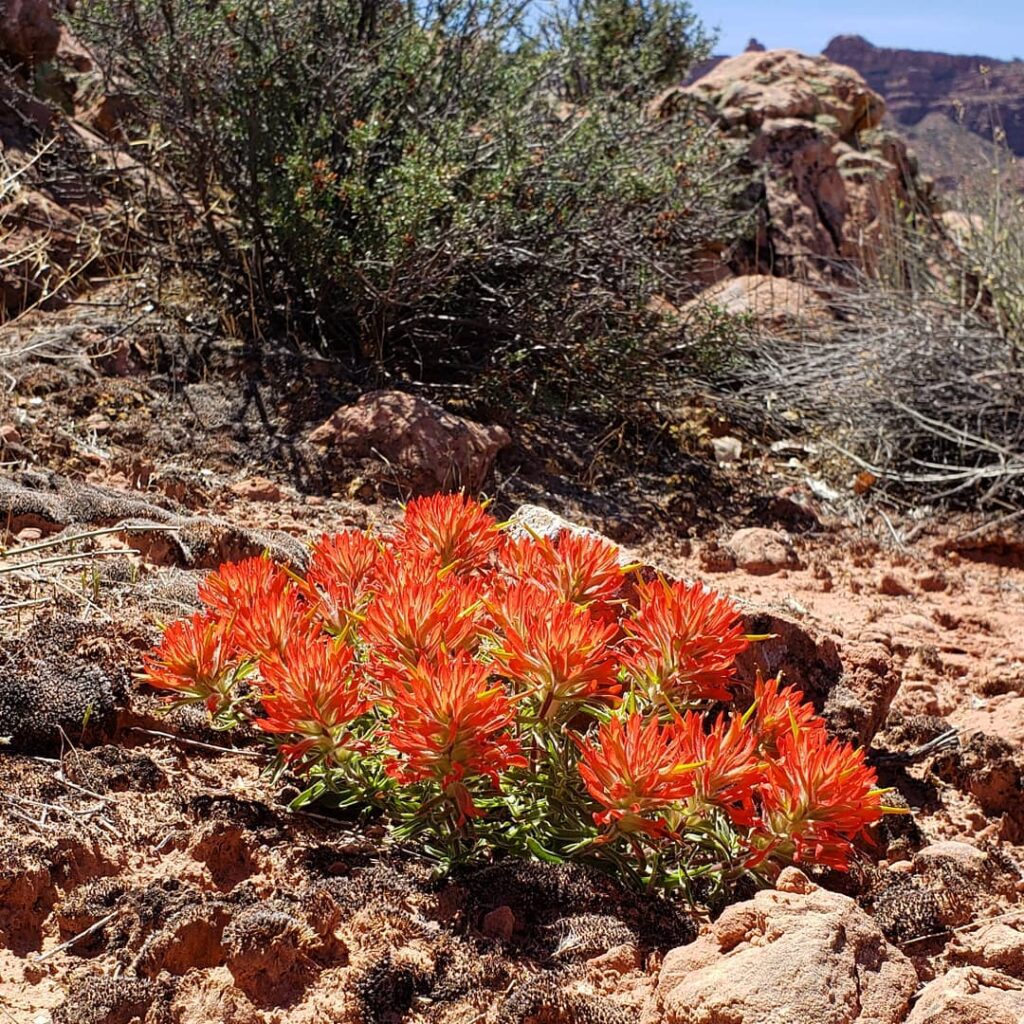
Desert Paintbrush (Castilleja chromosa) is a striking drought-tolerant wildflower native to Utah’s arid landscapes. Growing 12-18 inches tall, this semi-parasitic plant features bristly gray-green foliage topped with brilliant red-orange bracts that surround small tubular yellow-green flowers. The colorful bracts, often mistaken for petals, create spectacular spring displays that attract hummingbirds and butterflies.
This hardy wildflower thrives in Utah’s sagebrush scrub, pinyon-juniper woodlands, and desert environments from low elevations to montane zones. Its semi-parasitic nature allows it to obtain nutrients from neighboring grasses and shrubs, making it well-adapted to nutrient-poor desert soils. The softly hairy leaves and bracts help reduce water loss while providing protection from intense sunlight. The leaves are distinctively shaped as linear lance-shaped with 3 or 5 narrow fingerlike lobes, typically measuring 20-70 mm in length.
- Hardiness: USDA zones 4-8, tolerates elevation ranges from 1,600-10,500 feet
- Light: Full sun to partial shade
- Water: Low water requirements, drought-tolerant once established
- Soil: Well-draining, sandy to rocky soils; tolerates poor, nutrient-deficient conditions
- Fertilizer: None needed; obtains nutrients through semi-parasitic relationship with host plants
- Pest/Disease Resistance: Generally pest and disease resistant due to desert adaptations
- Growth Rate: Moderate; forms spreading clumps under favorable conditions
Penstemon (Beardtongue)
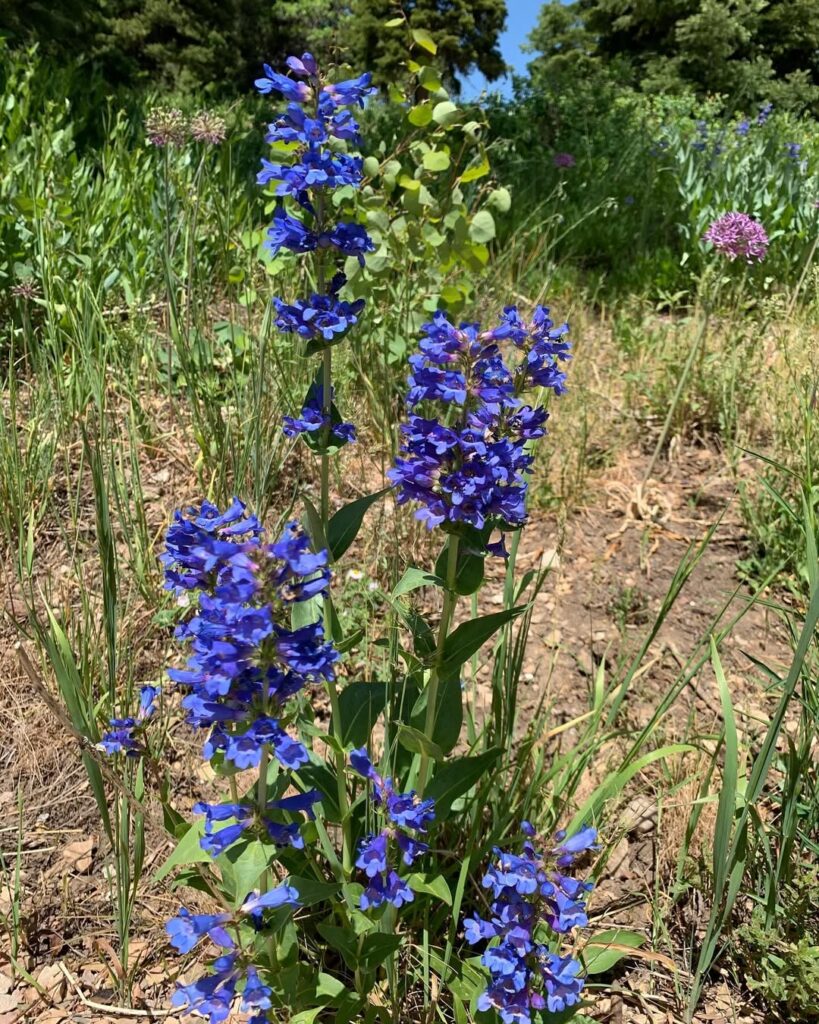
Utah hosts over 100 species and subspecies of native penstemon, commonly called beardtongue due to the hairy tongue-like staminode in their flowers. These remarkable wildflowers have adapted to thrive in harsh conditions where other plants cannot survive, from mountain ledges to desert floors and oil shale formations.
Notable species include Wasatch Penstemon with bright electric blue flowers, Marcus Jones’ Penstemon endemic to Utah’s Navajo Basin, and the popular Firecracker Penstemon. These drought-tolerant perennials serve as essential host plants for 19 native pollinators while providing nectar for insects and hummingbirds. Their ability to self-seed and prevent erosion makes them excellent choices for xeric gardens, pollinator habitat, and roadside restoration projects.
Penstemons can be easily identified by their distinctive features including opposite leaves and tubular flower shape with four filaments plus one furry filament.
- Hardiness: Extremely hardy, adapted to harsh Utah conditions
- Light: Full sun to partial shade
- Water: Very low requirements; minimal irrigation needed once established
- Soil: Well-draining sand or loam; avoid clay soils
- Fertilizer: Not required; adapted to nutrient-poor soils
- Pest/Disease Resistance: Deer-resistant and generally pest-free
- Growth Rate: Moderate; will self-seed and spread naturally
Blanket Flower (Gaillardia Aristata)
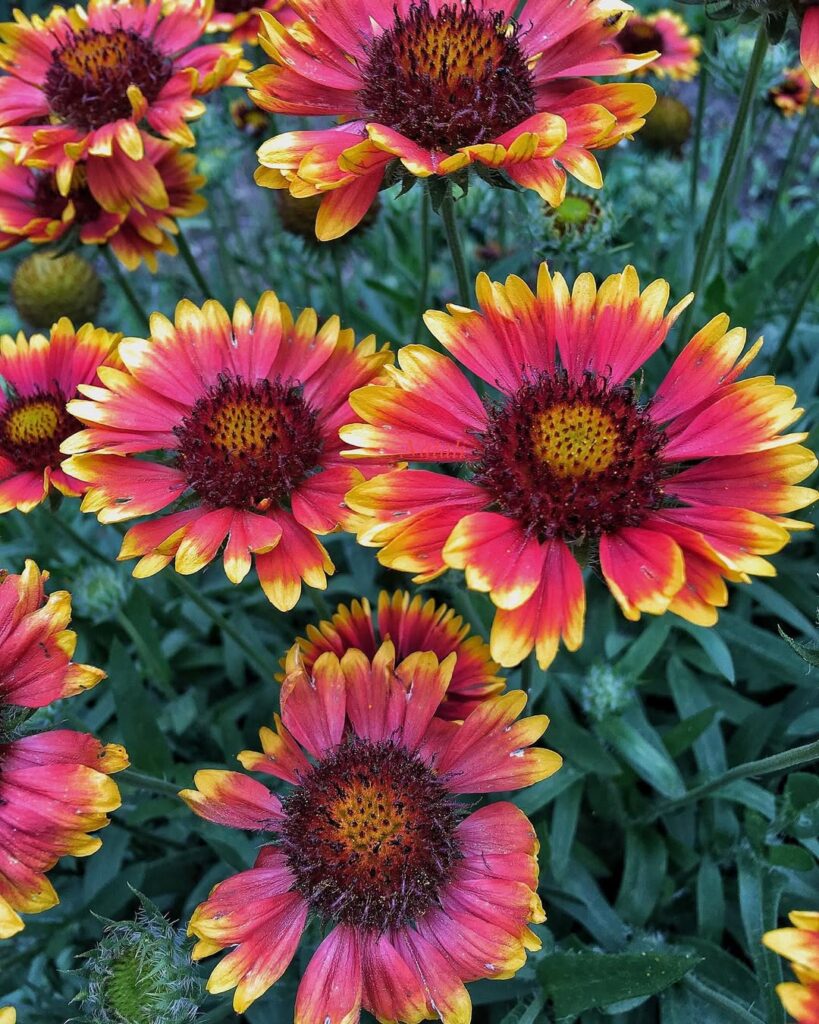
Blanket Flower (Gaillardia aristata) is a vibrant perennial wildflower native to Utah’s arid landscapes. This drought-tolerant member of the Asteraceae family produces striking daisy-like blooms with yellow, red, or bicolored petals from June through October. Growing 1-3 feet tall from a deep taproot, it features lance-shaped basal leaves and wiry stems topped with showy flower heads up to 4 inches across.
Ideal for xeriscaping and wildflower gardens, Blanket Flower thrives in Utah’s harsh conditions while providing essential habitat for native pollinators. Its long blooming season and low-maintenance nature make it an excellent choice for adding sustained color to drought-prone areas. The plant readily self-sows and works well for erosion control on disturbed sites. In natural settings, it commonly grows alongside big sagebrush, gambel oak, penstemon, and Kentucky bluegrass in mountain and upland communities.
- Hardiness: Extremely hardy in Utah’s climate zones, thriving in harsh mountain and upland conditions
- Light: Full sun exposure required for optimal growth and flowering
- Water: Highly drought tolerant; minimal supplemental watering needed once established
- Soil: Well-drained soils including loam, sand, silt, and gravel; tolerates acidic and slightly salty conditions
- Fertilizer: Low fertility requirements; minimal to no fertilization needed
- Pest/Disease Resistance: Resistant to most pests and diseases common in Utah’s arid climates
- Growth Rate: Moderate growth rate with deep taproot development of at least 16 inches
Utah Lupine (Lupinus Utahensis)
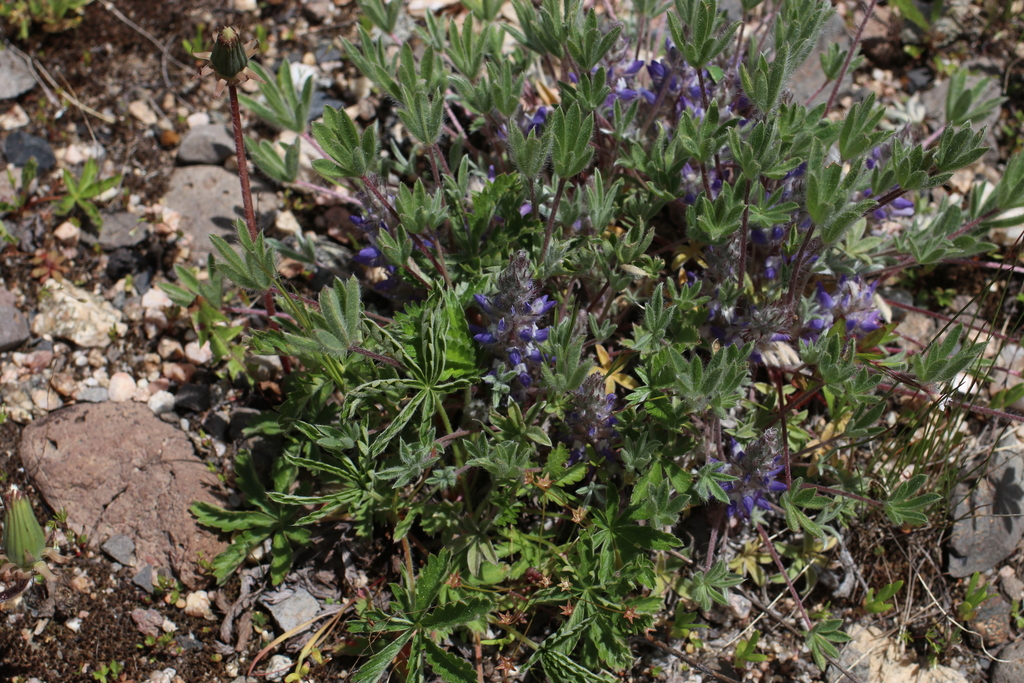
Utah Lupine is a hardy native perennial that grows 10-24 inches tall with distinctive palmately compound leaves and upright flower spikes. This drought-tolerant wildflower thrives across Utah’s diverse elevations from 1,370 to 3,810 meters, naturally occurring in Great Basin scrub communities and subalpine forests.
As a nitrogen-fixing legume, Utah Lupine improves soil fertility while providing essential habitat for native pollinators including bees and butterflies. Its deep taproot system makes it exceptionally drought-resistant and perfect for xeriscaping projects. Once established, this low-maintenance wildflower requires minimal care and helps stabilize soils on slopes and disturbed sites. The plant produces beautiful flowers that bloom from June to August, creating colorful displays throughout the summer months.
- Hardiness: Zones 4-8, tolerates extreme temperature fluctuations
- Light: Full sun to partial sun, thrives in open, exposed sites
- Water: Low water needs once established, drought-tolerant with deep taproot
- Soil: Well-draining, rocky or sandy soils; tolerates nutrient-poor conditions
- Fertilizer: None required; nitrogen-fixing capabilities enrich surrounding soil
- Pest/Disease Resistance: Generally resistant to most pests and diseases
- Growth Rate: Moderate establishment from seed, slow to moderate mature growth
Utah Evening Primrose (Oenothera acutissima)
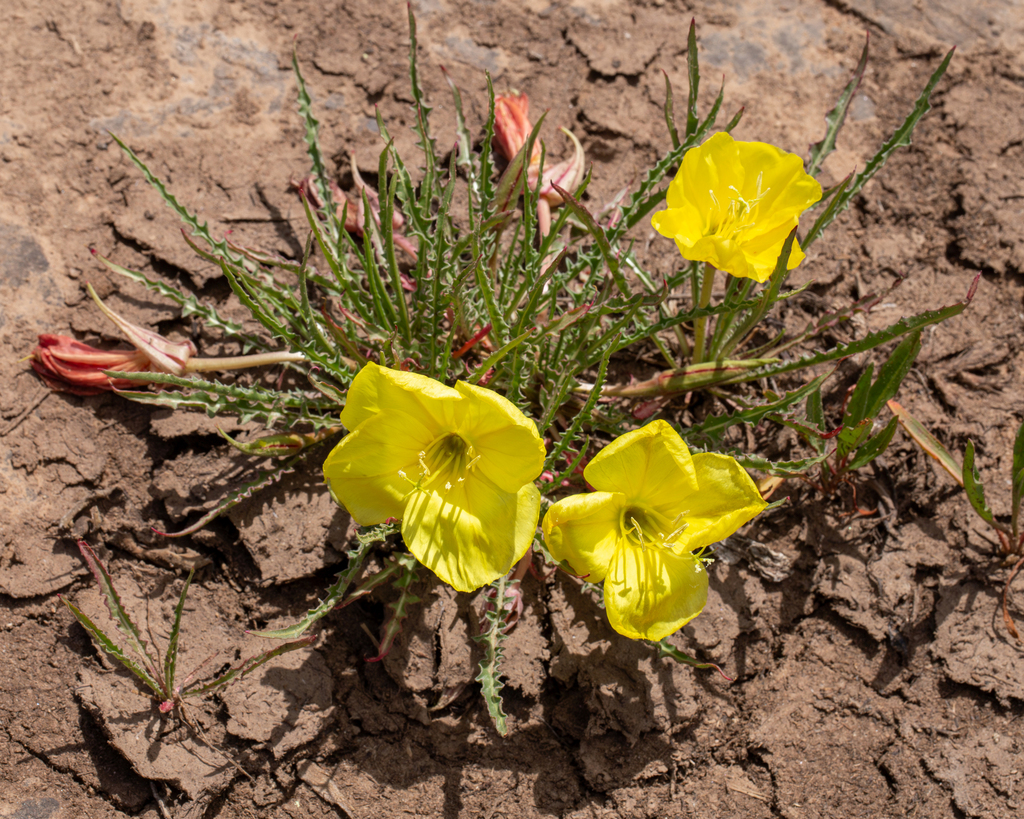
Utah Evening Primrose (Oenothera acutissima) is a resilient native wildflower well-adapted to Utah’s arid climate. This drought-tolerant species produces delicate four-petaled flowers that typically open in the evening hours, attracting nocturnal pollinators. Like other evening primroses in the Onagraceae family, it forms attractive rosettes of lance-shaped leaves and thrives in challenging growing conditions.
With its exceptional drought tolerance and ability to flourish in poor soils, Utah Evening Primrose makes an excellent choice for xeriscaped gardens and naturalized areas. The plant’s low-maintenance nature and pollinator appeal make it valuable for supporting local ecosystem diversity while providing reliable seasonal color in water-wise landscapes. As a herbaceous perennial, this soft-stemmed plant dies back in winter and produces fresh growth each spring.
- Hardiness: Zones 4-9
- Light: Full sun (6+ hours direct sunlight daily)
- Water: Low to moderate; drought tolerant once established
- Soil: Well-drained, tolerates poor and alkaline soils
- Fertilizer: Minimal requirements; adapted to nutrient-poor conditions
- Pest/Disease Resistance: Generally pest and disease resistant; deer resistant
- Growth Rate: Moderate
Utah’s Hardy Native Trees
Utah’s diverse climate zones support remarkably hardy native trees, from drought-tolerant desert species to high-elevation conifers, offering sustainable landscaping solutions for current and future conditions. The state hosts 48 native and naturalized tree species that have adapted to reproduce naturally in these varied environments.
Quaking Aspen (Populus Tremuloides)
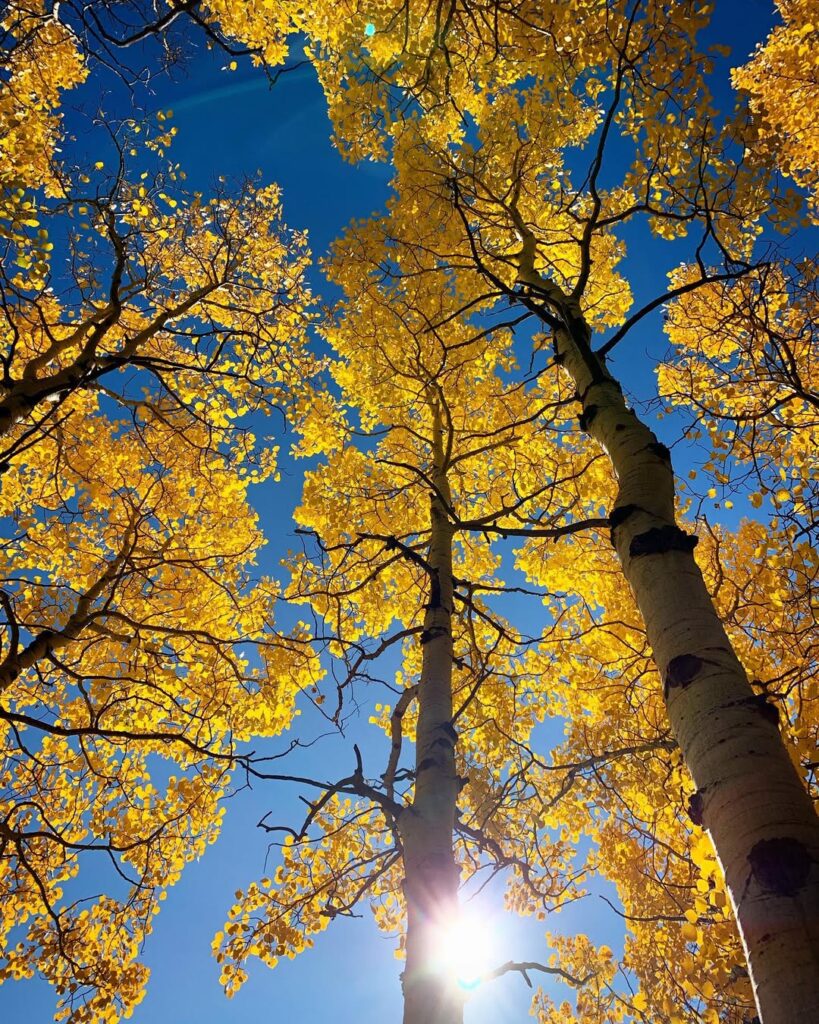
Quaking aspen stands as Utah’s most prominent native tree, covering nearly 60% of the state’s forest area. These remarkable trees reach heights of 82 feet and are instantly recognizable by their smooth, pale bark marked with distinctive black scars and glossy green leaves that transform into brilliant golden-yellow displays each autumn.
What makes quaking aspen truly unique is its ability to reproduce through root sprouting, creating vast clonal groves of genetically identical trees connected by a shared underground root system. This adaptation allows aspens to quickly colonize disturbed areas and form some of the largest living organisms on Earth, with some clones spanning hundreds of acres. The characteristic trembling of their leaves comes from flattened petioles that make the foliage quake even in the slightest breeze.
- Hardiness: Zones 1-6, thrives at elevations between 6,000-10,000 feet
- Light: Full sun required, not shade tolerant
- Water: Moderate to high moisture needs, adaptable to various moisture conditions
- Soil: Adaptable to shallow rocky soils to deep loamy sands and heavy clays; prefers well-drained, loamy soils high in organic matter
- Fertilizer: Low requirements when planted in nutrient-rich, organic soils
- Pest/Disease Resistance: Generally hardy but susceptible to conifer encroachment without disturbance
- Growth Rate: Fast-growing, especially after disturbances like fire or clear cutting
Utah Juniper (Juniperus Osteosperma)
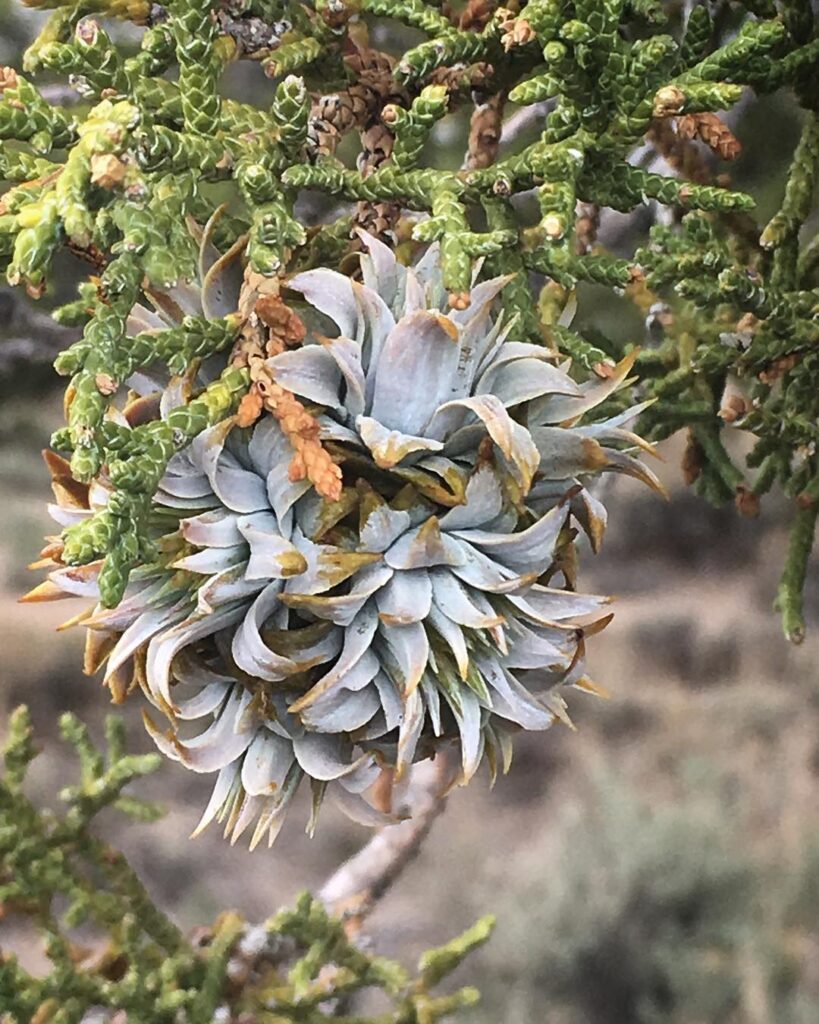
Utah Juniper (Juniperus osteosperma) stands as one of Utah’s most resilient native trees, dominating the state’s dry woodland communities between 1,300-2,600 meters elevation. This hardy evergreen typically grows 10-20 feet tall with a distinctive multi-stemmed, rounded crown and scale-like foliage. Known for its exceptional drought tolerance and longevity of up to 650 years, Utah Juniper serves as a keystone species throughout the southwestern United States.
Beyond its remarkable adaptability to harsh desert conditions, Utah Juniper provides critical wildlife habitat and helps stabilize soils in arid landscapes. The tree produces berry-like cones that feed numerous bird and mammal species, while its dense branching offers essential shelter and nesting sites. Its extensive root system and tolerance for poor, rocky soils make it invaluable for erosion control in Utah’s challenging terrain. Native Americans historically valued this versatile tree, using the fibrous bark for creating cordage, sandals, and woven materials.
- Hardiness: USDA Zone 5 (-28.8°C to -23.3°C)
- Light: Full sun, tolerates high solar exposure
- Water: Extremely drought tolerant, minimal water requirements once established
- Soil: Thrives in dry, rocky, poor soils; tolerates saline conditions
- Fertilizer: No fertilizer needed, adapted to nutrient-poor soils
- Pest/Disease Resistance: Highly resistant to most pests; minimal susceptibility except for juniper tip midge galls
- Growth Rate: Slow, persistent growth throughout long lifespan
Rocky Mountain Maple (Acer Grandidentatum)
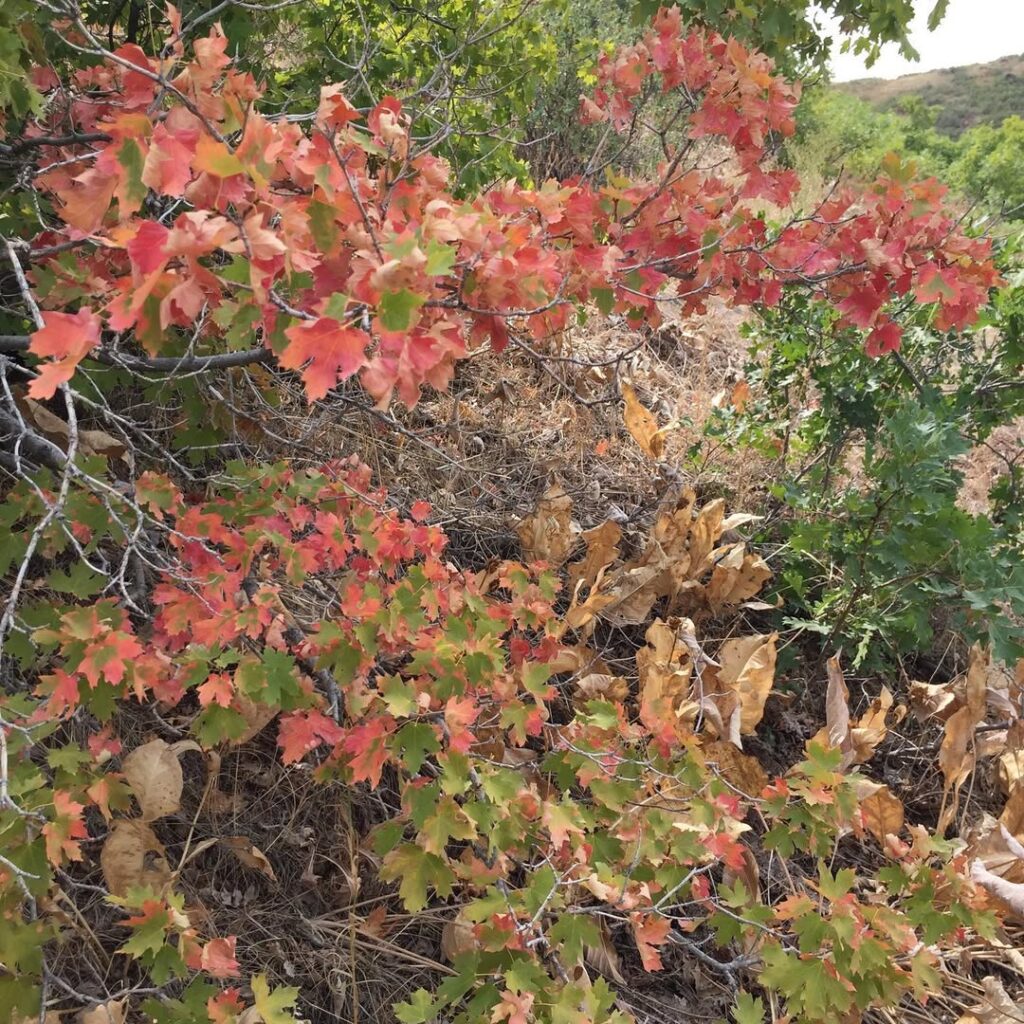
Rocky Mountain Maple (Acer grandidentatum) is a small, delicate native tree also known as Bigtooth Maple or Western Sugar Maple. Native to interior western North America, it thrives in moist, mountainous sites throughout Utah and the Interior West. This hardy tree features opposite branches, rounded twigs, and a narrow crown, making it an excellent landscaping choice for the region.
Closely related to the eastern Sugar Maple, Rocky Mountain Maple was historically used by western pioneers as a maple syrup source. The species shows great potential for cultivation, with the ‘Schmidt’ cultivar (Rocky Mountain Glow) currently under trial at Colorado State University, demonstrating promising ornamental characteristics for regional landscaping applications. This versatile tree readily resprouts from the root crown after damage, making it particularly resilient in challenging mountain environments.
- Hardiness: Cold hardy, adapted to mountainous western conditions
- Light: Partial shade to full sun
- Water: Moderate to high moisture requirements, prefers consistent watering
- Soil: Well-draining, moist soils; adaptable to various soil types
- Fertilizer: Low to moderate fertilizer needs; benefits from organic matter
- Pest/Disease Resistance: Generally resistant to major pests and diseases
- Growth Rate: Slow to moderate growth rate
Gambel Oak (Quercus Gambelii)
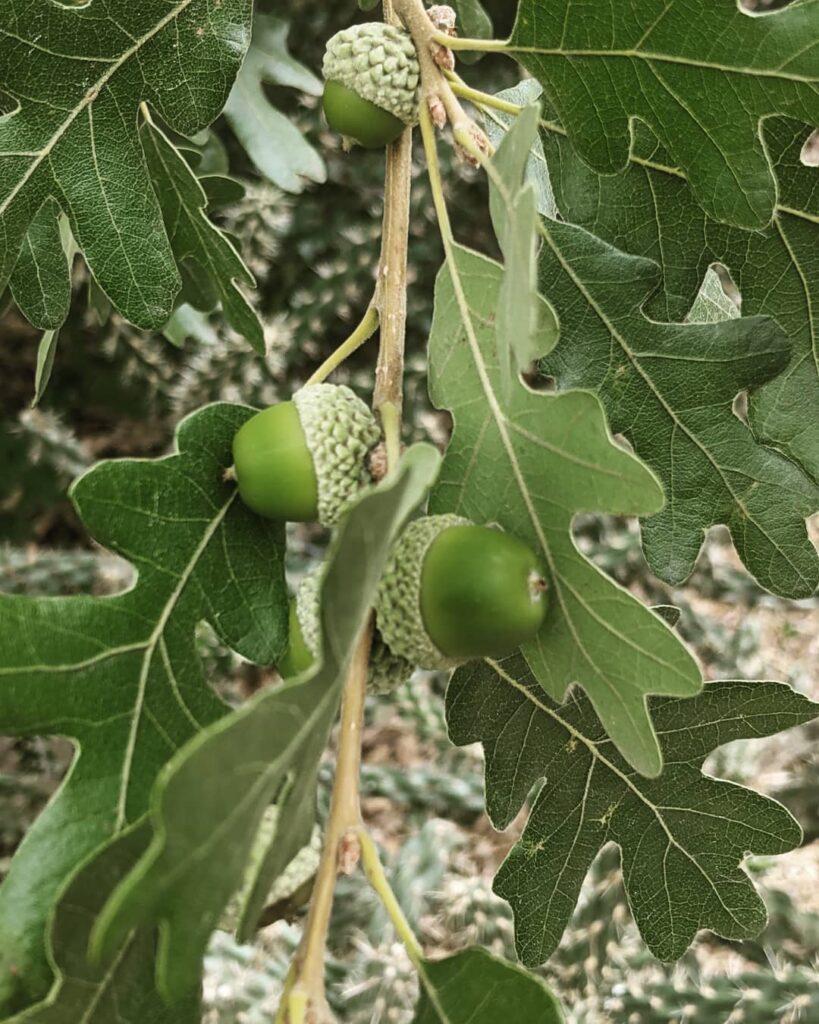
Gambel Oak is a hardy native shrub or small tree that reaches 20-30 feet tall with a 15-foot spread. This drought-tolerant species features deeply-lobed deciduous leaves and produces acorns that provide valuable wildlife food. With its lignotuber root system and xeromorphic adaptations, it thrives in Utah’s challenging conditions from 3,000 to 9,700 feet elevation.
Named after naturalist William Gambel, this Rocky Mountain native forms dense groves and offers excellent habitat for birds while serving as browse for deer. The wood is useful for fenceposts and fuel, making it both ecologically and practically valuable for Utah landscapes. The leaves can serve as garden mulch to regulate soil temperature and improve water retention in landscaping applications.
- Hardiness: USDA zones 4-8, elevation range 3,000-9,700 feet
- Light: Full sun required
- Water: Excellent drought tolerance once established, no irrigation needed
- Soil: Well-adapted to rocky sites and alkaline soils, thrives in various soil types
- Fertilizer: No fertilizer requirements due to native adaptation
- Pest/Disease Resistance: High resistance, well-adapted to harsh growing conditions
- Growth Rate: Medium to rapid growth when young, declining with age
Pinyon Pine (Pinus Edulis)

The Pinyon Pine is a hardy evergreen native to Utah’s arid landscapes, forming the backbone of pinyon-juniper woodlands throughout the state. This compact tree reaches 10-35 feet tall with distinctive gray-green needles in pairs and produces edible seeds that have sustained wildlife and Native Americans for centuries. While challenging to establish, it’s perfectly adapted to Utah’s dry climate and makes an excellent choice for water-wise native landscaping.
The annual harvest of pinyon nuts exceeds 1 million pounds, making this tree economically significant beyond its ecological value. Utah’s elevation range of 4,500 to 7,500 feet provides ideal growing conditions where these trees receive 12 to 18 inches of annual precipitation.
- Hardiness: USDA zones 4-8
- Light: Full sun (minimum 6 hours daily); shade intolerant
- Water: Very low once established; critical winter moisture needed first 2-3 years; avoid over-watering
- Soil: Adapts to dry, poor soils; drought tolerant
- Fertilizer: Not required; adapted to nutrient-poor native soils
- Pest/Disease Resistance: Generally resistant but requires monitoring
- Growth Rate: Slow to moderate
Resilient Native Shrubs for Utah
Utah’s native shrubs offer exceptional drought tolerance, provide essential wildlife habitat, prevent soil erosion, enhance landscape beauty, and are increasingly available through commercial nurseries statewide. These hardy species require less water compared to non-native alternatives, making them ideal choices for sustainable landscaping in Utah’s arid climate.
Serviceberry (Amelanchier Utahensis)
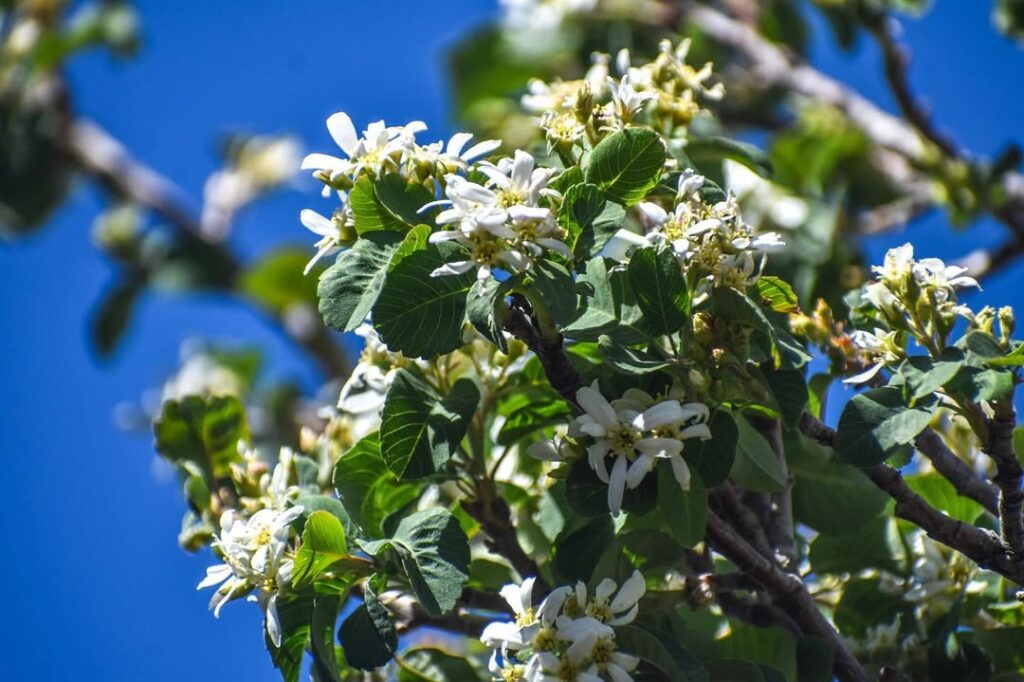
Utah Serviceberry (Amelanchier utahensis) is a versatile deciduous shrub or small tree that serves as an exceptional choice for Utah’s challenging landscapes. Growing 6-15 feet tall with a spreading habit, this native plant produces spectacular clusters of white flowers in early spring that completely cover the branches, followed by purplish-black berries that provide essential food for wildlife.
This hardy shrub thrives in elevations from 3,000 to 9,000 feet throughout the Great Basin, making it perfectly adapted to Utah’s varied terrain. Its glossy green foliage transforms to brilliant golden yellow in fall, while the deep burgundy-red bark adds winter interest. Beyond its ornamental value, Utah Serviceberry plays a significant ecological role, serving as an important food source for mule deer and providing nesting habitat for birds while supporting pollinators during its April through June blooming period.
Establishment can be slow growth, taking 8 to 10 years for the plant to reach flowering and seed production maturity.
- Hardiness: Zones 5-8, winter hardy and adapted to Great Basin conditions
- Light: Full sun for ideal flowering and fruit production
- Water: Very drought tolerant once established, suitable for hot, dry areas
- Soil: Coarse to medium well-drained soils with excellent drainage required, not salt tolerant
- Fertilizer: Low maintenance, adapted to poor soils, minimal fertilizer needs
- Pest/Disease Resistance: Generally resistant, well-adapted to Utah’s native conditions
- Growth Rate: Moderate, reaching mature size of 6-15 feet tall and 6-10 feet wide
Antelope Bitterbrush (Purshia Tridentata)

Antelope Bitterbrush is a highly adaptable perennial shrub native to Utah’s intermountain region, thriving from low valleys to elevations of 7,000 feet. This resilient plant grows 3-10 feet tall with variable forms, producing white to yellow flowers from May through June. It plays an essential ecological role, providing vital winter browse for mule deer, elk, and pronghorn while offering excellent erosion control and ground cover.
The species excels in Utah’s diverse habitats, from arid sagebrush steppe to montane forests, often forming mixed shrub communities with sagebrush and pinyon-juniper. Its exceptional drought tolerance and ability to thrive in poor soils make it invaluable for restoration projects and xeriscaping, requiring minimal maintenance once established. The plant develops root nodules that fix nitrogen, enhancing its ability to survive in nutrient-poor conditions.
- Hardiness: Cold hardy, tolerates Utah’s harsh winters and hot, dry summers
- Light: Full sun required for ideal growth and flowering
- Water: Drought tolerant once established; thrives with 10-15 inches annual precipitation; minimal irrigation needed
- Soil: Well-drained sandy, rocky, loam, silt, or gravel soils; tolerates acidic to alkaline pH; intolerant of waterlogged conditions
- Fertilizer: Thrives in low-fertility soils; no supplemental fertilization required
- Pest/Disease Resistance: Excellent resistance to pests and diseases; resilient to browsing damage
- Growth Rate: Moderate growth rate with high germination potential
Four O’Clock (Mirabilis Multiflora)
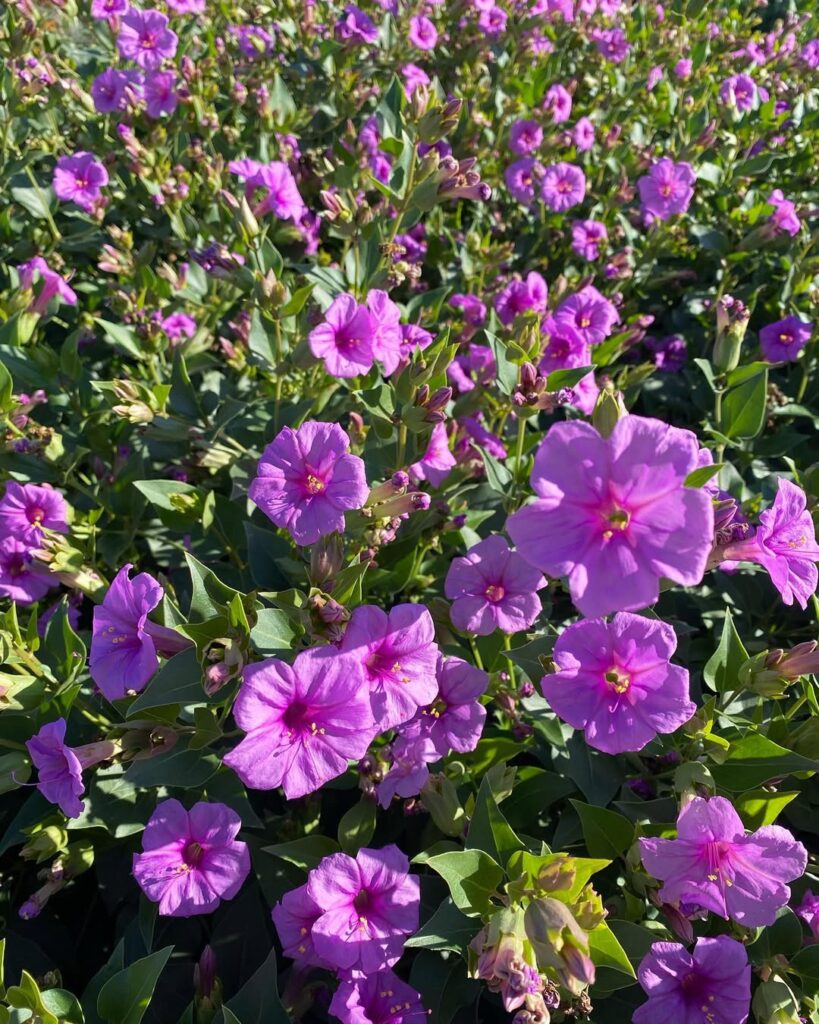
Four O’Clock (Mirabilis multiflora) is a resilient native perennial endemic to Utah’s pinyon-juniper woodlands and short grass prairies. This sprawling herbaceous plant reaches 15-24 inches tall while spreading 4-8 feet wide, making it excellent for ground coverage in xeriscape gardens.
The plant produces stunning magenta-pink flowers that bloom from mid-summer through first frost, opening in late afternoon and remaining open through the night. Its thick taproot and semi-succulent foliage make it exceptionally drought tolerant, while its evening blooms attract hummingbirds, moths, and other night pollinators. The stems die back in winter but regrow vigorously each spring. The plant’s fleshy tap root makes it unsuitable for transplanting once established.
- Hardiness: USDA zones 3-8, tolerates both cold and hot Utah conditions
- Light: Full sun
- Water: Drought tolerant, little to no supplemental water once established
- Soil: Tolerates clay, sandy, poor, rocky, or disturbed soils; not salt-sensitive
- Fertilizer: None needed
- Pest/Disease Resistance: Deer and rabbit resistant
- Growth Rate: Moderate to fast once established
Big Sagebrush (Artemisia Tridentata)
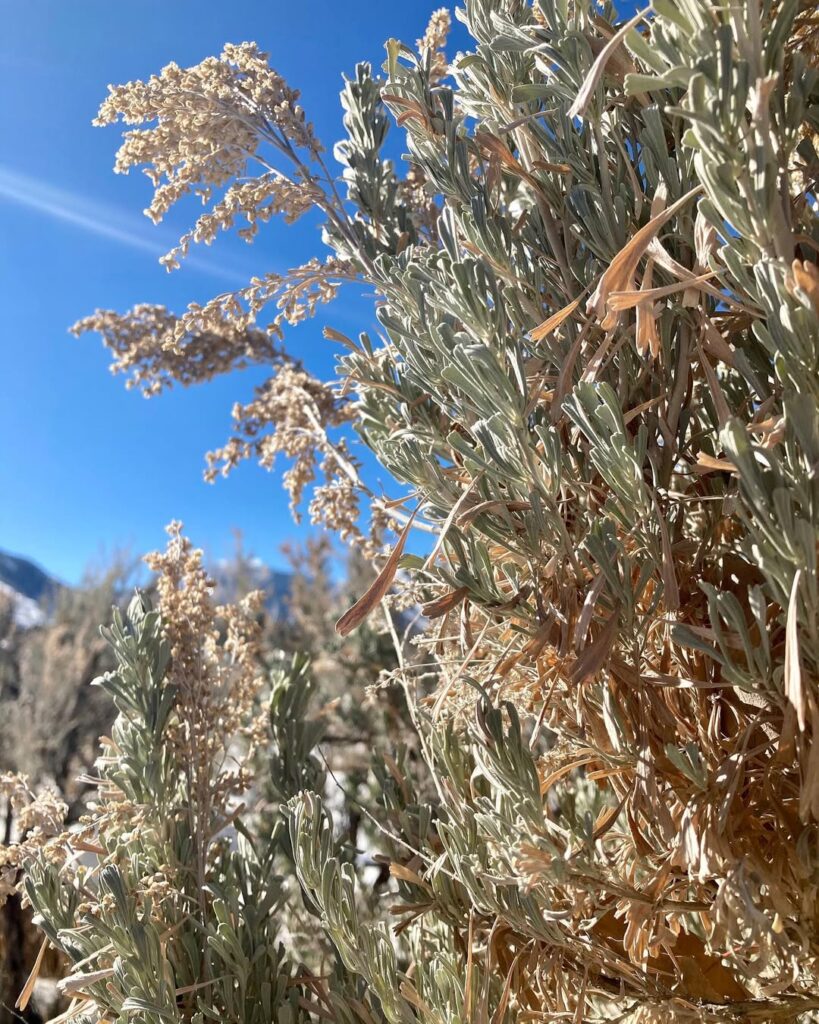
Big Sagebrush (Artemisia tridentata) stands as Utah’s most widely distributed native shrub and a keystone species of the Great Basin ecosystem. This woody, aromatic perennial can reach impressive heights of 13-15 feet and produces distinctive yellow flowers from August through September. As the most important shrub on western rangelands, it provides critical habitat and food for sage grouse, mule deer, pronghorn, and numerous other wildlife species.
The species demonstrates remarkable adaptability, thriving across elevations from 2,500 to 10,000 feet and tolerating both drought conditions and disturbed sites. Its deep root system and perennial nature make it invaluable for erosion control and ecosystem restoration projects throughout the Intermountain West. Big Sagebrush is exceptionally long-lived, often exceeding 100 years once it survives the vulnerable seedling stage.
- Hardiness: USDA zones 4-8, tolerates extreme temperature variations and harsh mountain conditions
- Light: Full sun, thrives in open landscapes with minimal shade
- Water: Low water requirements, 8-16 inches annual precipitation, drought tolerant once established
- Soil: Adaptable to various soil types including deep loamy, sandy, alkaline, and salt-rich soils; prefers well-draining conditions
- Fertilizer: No fertilization needed, adapted to nutrient-poor soils
- Pest/Disease Resistance: Excellent resistance to most pests and diseases, highly resilient native species
- Growth Rate: Slow growth rate with high establishment success
Oakleaf Sumac (Rhus Trilobata)

Oakleaf Sumac (Rhus trilobata) is a highly adaptable native shrub that thrives throughout Utah’s diverse landscapes. This deciduous plant typically reaches 2-8 feet in height and width, featuring distinctive three-lobed leaves that transform into brilliant autumn colors of yellow, orange, and red. Its dense, multi-branched structure makes it excellent for privacy screens and erosion control.
This resilient shrub produces small chartreuse flowers in spring followed by red-orange berries that provide essential food for wildlife. Its ability to spread through root suckers allows it to form natural colonies, making it invaluable for slope stabilization and habitat restoration. The plant’s drought tolerance and low maintenance requirements make it ideal for xeriscaping and sustainable landscaping practices. For optimal berry production, it’s important to plant both male and female plants since this species requires cross-pollination for successful fruit development.
- Hardiness: USDA Zones 4-8, tolerates cold winters
- Light: Full sun to partial shade
- Water: Low water needs, highly drought-resistant once established
- Soil: Tolerates wide variety including rocky, poor, and disturbed soils
- Fertilizer: No fertilizer required, thrives in nutrient-poor conditions
- Pest/Disease Resistance: Excellent resistance to most diseases and pests
- Growth Rate: Moderate, spreads by root suckers to form colonies
Selecting the Right Native Plants for Your Garden
How do you choose the perfect native plants that’ll thrive in your Utah garden without constant fussing? Start by mapping your yard’s garden microclimates, noting sun and shade patterns throughout the day. Measure moisture levels and soil drainage in different areas.
Match plants to their preferred conditions. Group species with similar water and light needs together for efficient plant companioning. Sego Lilies love sunny, dry spots, while some natives tolerate shadier areas.
Consider mature plant sizes to prevent overcrowding. Use reliable guides like Red Butte Garden’s Utah Native Collection for proper identification and spacing requirements. Research from Utah State University emphasizes whole-plant responses to water stress when selecting drought-tolerant species.
Frequently Asked Questions
Where Can I Purchase Native Utah Plants Locally?
You can purchase native plants at local nurseries like Cache Valley Native Plants, Glover Nursery, or Valley Nursery. Native plant nurseries and local gardening clubs often provide expert guidance for Utah’s climate conditions.
How Much Do Native Plants Typically Cost Compared to Non-Native Varieties?
Purchasing perennial plants presents pricing puzzles. You’ll find native plant pricing typically costs $7-17 per plant versus $3-8 for non-natives initially, but cost comparison favors natives long-term through reduced water, fertilizer, and maintenance expenses.
What Is the Best Time of Year to Plant Native Species?
For seasonal planting and ideal growth, you’ll find fall’s your best choice, particularly late August through early September. Cool temperatures reduce stress while establishing roots, and consistent rainfall supports development better than spring’s unpredictable conditions.
Do Native Plants Require Special Soil Preparation Before Planting?
Your garden’s foundation deserves attention before welcoming new residents. You’ll need to assess soil composition, incorporating organic matter and adjusting pH levels. Proper planting techniques include shallow seeding and strategic mulching for ideal establishment.
How Long Does It Take for Native Plants to Become Established?
The establishment timeline for native plants typically spans one to two growing seasons before they’re fully established. Growth factors like plant type, watering consistency, and seasonal conditions will affect how quickly your plants develop strong root systems.
